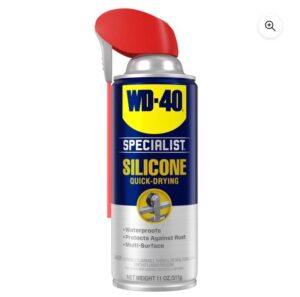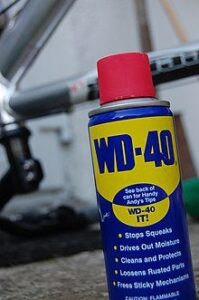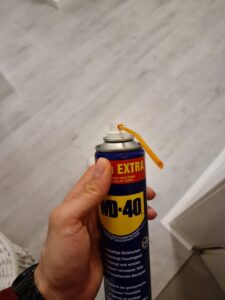WD-40 is a popular multi-purpose lubricant and cleaner that is widely used to loosen rusted or stuck parts, protect metal surfaces from corrosion, and clean away grime and dirt. However, it can also leave behind a residue that can be difficult to remove.
Whether you’re a mechanic, DIY enthusiast, or simply want to know how to properly maintain your tools and equipment, this guide will provide you with the knowledge and techniques you need to get the job done.
How to clean wd40 off metal
If you’ve used WD-40 to lubricate or protect a metal surface, you may have noticed that it can leave behind a thin, waxy residue. This residue can attract dirt and grime, and over time it can build up and make the metal look dirty and greasy. If you want to remove WD-40 from metal surfaces and leave them clean and residue-free, here’s what you need to do:
- Wipe away excess WD-40: Start by wiping away as much of the excess WD-40 as possible with a clean cloth. Be sure to use a cloth that is lint-free to avoid leaving behind any fibers.
- Clean with a degreaser: Next, use a degreaser or all-purpose cleaner to loosen and dissolve the remaining WD-40 and any dirt or grime that may be present. Spray the degreaser onto the metal surface and let it sit for a few minutes to allow it to penetrate and break down the residue.
- Scrub the surface: Once the degreaser has had a chance to work, use a scrub brush or a scouring pad to scrub the metal surface. This will help to loosen and remove any remaining WD-40 and dirt.
- Rinse with water: Once you’ve scrubbed the surface, rinse it thoroughly with water to remove the degreaser and any remaining dirt or grime. Be sure to rinse the surface completely, as any remaining degreaser can leave behind a residue of its own.
- Dry the surface: After rinsing, dry the metal surface thoroughly with a clean cloth to remove any moisture. This will help to prevent rust from forming and will ensure that the metal is clean and ready for use.
By following these steps, you can effectively clean WD-40 off of metal surfaces and leave them clean and residue-free. Whether you’re a mechanic, DIY enthusiast, or simply want to maintain your tools and equipment, these tips will help you get the job done.
How long does WD-40 stay on metal?
WD-40 is designed to provide long-lasting lubrication and protection to metal surfaces. When applied to a clean, dry surface, it can remain effective for several months or even longer, depending on the conditions and the type of metal.
However, it’s important to note that WD-40 is not a permanent solution, and it will eventually wear off or evaporate over time. The exact amount of time it will remain effective will depend on a variety of factors, including the type of metal, the amount of wear and tear the metal is subjected to, and the environmental conditions it is exposed to.
In general, it’s a good idea to reapply WD-40 every few months or as needed to ensure that the metal surface is adequately lubricated and protected. This will help to prevent rust and corrosion and will keep the metal in good condition.
Can WD-40 damage metal?
WD-40 is a penetrating oil that can be used to protect metal from rust and corrosion. It is not intended to be used as a lubricant and should not be used on moving parts. If used excessively or left on a surface for an extended period of time, WD-40 can leave a residue that can attract dirt and dust, which could potentially damage metal surfaces.
It is generally best to use a specific lubricant or rust preventative product on metal surfaces that will be subjected to movement or friction.
Can you use acetone to clean WD40 off metal?
Acetone is a strong solvent that can be effective at removing WD-40 from metal surfaces. However, it is important to note that acetone can also damage some types of metal and certain finishes.
It is generally best to use a cleaner that is specifically designed for the type of metal or finish you are working with. If you do choose to use acetone to remove WD-40 from a metal surface, it is important to test it in a small, inconspicuous area first to ensure that it does not cause any unwanted damage.
After using acetone to remove WD-40, be sure to thoroughly wash the metal surface with soap and water to remove any residual acetone before applying any other products.
What neutralizes WD-40?
WD-40 is an oil-based product and is best removed with a solvent that is capable of dissolving oil. Some common solvents that can be used to neutralize WD-40 include acetone, mineral spirits, and denatured alcohol.
These solvents can be used to dissolve and remove WD-40 from surfaces. After using a solvent to remove WD-40, it is important to thoroughly clean the surface with soap and water to remove any residual solvent.
This will help to prevent any unwanted reactions or damage to the surface. It is generally best to use a solvent that is specifically designed for the type of surface you are working with, as some solvents can damage certain materials.
Other cleaning guides
How To Clean Up Spilled Paint Thinner (Complete Guide)
How To Clean Enamel Paint From Paintbrush (Restore Your Brush!)



